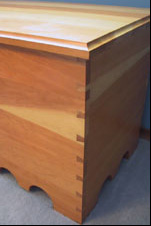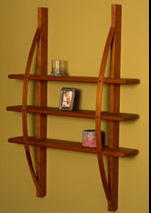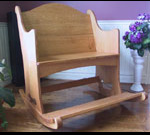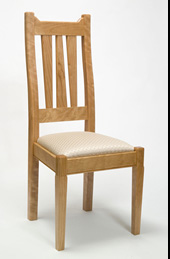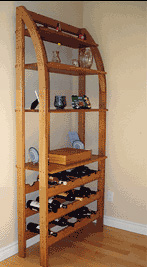
They say the best laid plans often go astray, and that tends to be even more common when the plans are made for us by someone else. Hendrik Varju, a designer and craftsman of fine furniture, is a perfect example of that. His parents wanted him to become a lawyer, and he did just that, at least for a time. After all, his father, a Hungarian immigrant, grew up in very challenging circumstances and had good reasons for planning something better for his son.
“When he was four,” Hendrik told me, “my father’s mother died. His father gave up him and his four siblings to the police because he could not raise them. The foster parents who took my father in really wanted a farmhand more than a son. His whole life became all about work and surviving. Consequently, my father hated his father and never desired to see him again. Once he came to Canada, it was like getting out from under, and it was too painful to look back. He has never returned to Hungary even for a visit.
“I grew up helping my father, who worked as a house painter, handyman, and home repairman. Where he grew up, in Communist Hungary, teaching your son to work and to understand the value of a dollar was important. I started working with him around the house at four or five, and by the age of seven he was taking me on jobs with him to help out whenever I was not in school.
“His intent in taking me to work with him was apparently to teach me what not to do, and induce me to instead stay in school and become a lawyer. He was illiterate but wanted something better for me. He did enjoy his work, but felt he had no choice but to work with his hands because of his lack of education. He wanted me to have more options. He bought into the bias that people who work with their hands do so because they are not intelligent enough to become professionals.”
For a time, that influence worked. Hendrik dutifully left college with a degree in law and practiced law for three years, but it did not last. Soon something more enticing came his way. “It was my parents’ idea that I become a lawyer, not mine, and I did not enjoy it. I did not want to be part of the backstabbing and unethical conduct around me.
“During that time, I was living in an apartment and doing woodworking as a hobby on my kitchen table, using only hand tools. Mostly I built small things for the house and for Christmas gifts. I used to go camping with my wife, and one day we met a German woodworker near where we camped. He had a more frugal life than I did, but in spite of that, meeting him made me consider changing what I did and the way I lived. Within a couple of months, I had made the decision to quit my law practice and start my own business.
“We were at the point where we were about to buy a home with a huge mortgage, and I knew that once we had kids and a house I would not be able to make the change. My wife worked with the regulatory group that deals with nurses in Ontario. We met in law school, but she also decided not to become a lawyer. She understood why I did not want to practice law because she had made the same choice.
“My parents were less understanding. They were disappointed and were convinced I was making a foolish move. When I quit practicing law, my father continued for years to introduce me as a lawyer. If I had said to my father that I actually wanted to enjoy my work, he would respond that you are not supposed to enjoy work. It is about making money, not having fun.
“We moved in with my in-laws, and I set up my first woodworking shop in their basement. That gave me some time to operate rent-free until I gathered some customers. My first customers were friends and family, and word spread. A year and a half later, we bought a house in the country with an attached garage. I added an addition, and it became my shop.
“Around 2000, I started writing for a Canadian home workshop magazine, and have since written for four different magazines in the U.S. and Canada. I saw it as an extension of teaching that allowed me to reach more people. It tends to bring in more teaching business and does help close the deal with customers. While writing does not glean furniture orders, my being published does impress potential clients. I also have a self-published book on how to start a woodworking business, which grew out of the material handouts from a course, and a self-made DVD on joiner and planer use. Included in the book are contracts and legal papers relating to the woodworking business, a throwback to my legal background.”
Though teaching is not as rewarding as building, it does have its own rewards. Teaching privately, writing, or making DVDs involves gaining recognition for techniques that you developed yourself the hard way. I still need to create by myself, but breaking it up by teaching, writing, repairing and building creates a good mix and prevents boredom.
Hendrik also sees a strong connection between woodworking and cooking, and that can show up in his teaching. “Not long ago I taught a course called ‘Cooking and Woodworking: The Connection.’ The gist of it was that even when I am cooking, different woodworking concepts pop into my head. For instance, when I look at meat, I look at where the end grain is and where I can cut into it without losing the juice, such as along the grain, but not across it. I look at cutting tools and how they work and at growth rings in onions, which look remarkably like those in a tree. The point I was making is that there is a tremendous similarity between wood and other things that grow.
“To be comical, during the course I sliced mushrooms with a block plane and cut onions with a 20-inch planer knife. I use paprika on meat for the same reason I use red coloring in many woods. Oranges and reds in wood are more inviting. I suspect it goes back to the comfort of sitting around a fire.”
When it comes right down to it, no matter what Hendrik is doing, the end result is similar. “My goal, when building, teaching, or for that matter, even cooking, has to do with creating beautiful things with your hands, and making people happy.”
